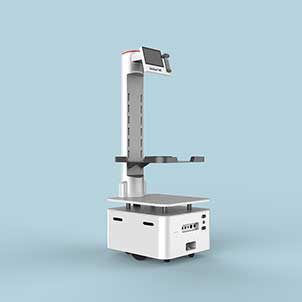focus on robot ODM
News
EN
The flexible here is relative to the manufacturing process. In the production line, because the manufacturing process can not be easily changed, so the movement of logistics robot is relatively fixed and high repetitive. However, in the field of logistics, there may be many ways to move from point A to point B, which has great uncertainty.
In addition, robots may encounter obstacles during the path from point A to point B. On the one hand, there may be other robots moving; on the other hand, there may be people moving and other unexpected situations. This variable "flexible" process puts forward higher requirements for robots.
The new generation of warehouse logistics robots can not only move on flat surfaces, but also recognize and interact with more elements in their environment. A classic example is a robot taking an elevator, as shown in Figure 2. A service robot in a hotel can interact with an elevator by transmitting a wireless signal, enter its interior and select the right floor to deliver items to a specific room on the floor. The author observed that the function of "taking an elevator" has become the standard of more and more robot brands.

If logistics robots want to play the characteristics of flexibility and interact with external objects, they must “see the objects”first and can correctly identify the surrounding environment. Under this demand, laser navigation technology is rising gradually. Before the advent of this technology, logistics robots were mainly guided by fixed paths (such as magnetic guides buried in the ground), which obviously lacked flexibility. Robots can also rely on a large number of QR codes on the ground to constantly calibrate their position, but this method requires relatively good environment, and the QR codes are also prone to wear.
Laser navigation technology can be subdivided into laser baffle navigation and SLAM navigation. Laser baffle navigation needs reflectors in the surrounding environment to assist laser positioning, so the navigation effect will be affected because of obstacles in the environment. SLAM (Simultaneous Locating and Mapping) is means a robot can locate itself and generate a map as it moves.It doesn't require a lot of hardware in the surrounding environment. The robot can depict the surrounding environment and draw it in real time with the reflected results of the laser (see the lower part of Figure 3). This technology is already being used in a variety of logistics robots and driverless vehicles.
As can be seen from the previous trends, modern logistics robot equipment needs to have three capabilities: "State Awareness" (the state of the robot and its surroundings),"Real-time Decisions" (how to act in a given situation), and "Accurate Execution" (making precise actions as a result of a decision).
Accordingly, Internet of Things technology, artificial intelligence and robotics precisely correspond to the "perception", "decision" and "execution". The high-performance robotic equipment of the future is not just hardware, but a combination of these three technologies. It allows data to flow freely and allows algorithms to direct hardware to do its best.